We traveled to the Metropolitan Museum of New York, the MET, to stand in front of a sculpture, well, actually a fragment of a queen’s head, what’s left of a figure made more than 3,000 years ago, around 1350 BC, in a period known as the New Kingdom, in Ancient Egypt.
A miracle, for lack of a better word. Let’s try to imagine the history of the piece. First of all, the rock: yellow jasper. The millennia of sedimentation and the geological processes that led to its formation. A rock that due to its characteristics (its color, its hardness and its accessibility) drew the attention of our ancestors who decided to excavate and extract it from the earth. They carved a block that could be transported and brought it to a sculptor’s workshop so that this man, with a chisel and a hammer, could shape the stone. He began to remove pieces of rock and little by little he was shaping the stone until it became a sculpture. Let’s think about that moment, the moment in which the simple rock becomes a shape, it stops being a stone to be a figure. There is a moment in the process when the rock is already a presence, it represents something. The sculptor will continue to work on it until he polishes the surface of the appearance, shiny as a mirror: the face of a woman, a queen, perhaps also a goddess.
–
For several years, that sculpted rock, that shape created with human hands, it represented and symbolized the earthly power and surely also the heavenly one. Many men and women knelt before her, admiring her with devotion and perhaps also afraid of her, as if she were more than just a carved stone.
Over time, the sculpture fell. She did it because the cult she represented fell into oblivion or fell because she was intentionally thrown to the ground by another cult, by another culture. New gods, embodied in other stones, replaced the old gods.
In any case, the sculpture fell and broke into several pieces. One of the fragments preserved the figure’s lips and chin. This fragment remained buried, buried, for millennia in the sand of the desert until someone unearthed it, in the early 20th century, and sold it to an English lord in Cairo.
The piece, now preserved as a relic, reached the Metropolitan in New York where we can admire it and where, even today, it dazzles us with its beauty. What I said before, a miracle.
The beauty and the ability to evoke from a simple fragment
The beauty of this fragment is incredible and how it evokes all the missing face. There are no eyes and yet he looks at us. We do not have the nose or ears, only the lips remain. But what lips: the curve, the voluptuousness.
It is extraordinary how the sculptor has outlined the lips with an edge. In the human face, the lip differs from the skin of the face due to the change in color, but in the sculpture the lip and the skin of the cheek are the same yellow, to differentiate it the sculptor has chiseled an edge, a slight change in plane , which catches light and shadow and draws lips in space.
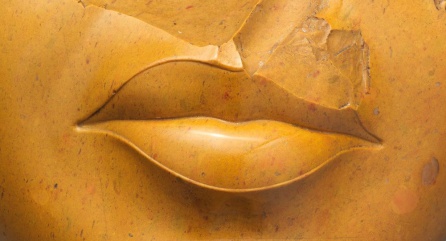 –
–The sensuality of these lips, but at the same time the personality and character that it transmits. It has a sought after sensuality but let’s not forget that it is the image of a queen.
Who was?
We cannot know for sure, but we can try to imagine who it was. We know that it belongs to the period of the New Kingdom, during the reign of Akhenaten, which puts us on the trail of some real women who existed. The material, yellow jasper, is a precious stone and this leads us to think that it was a queen:
- Akhenaten’s mother: Although for many historians the lips are too sensual for the image of an older woman, just as she must have been when the sculpture was made.
- There are some hypotheses that, due to the resemblance to the lips of other complete preserved sculptures, they believe that it could be la reina Kiya o la reina Tiye. Although no hypothesis is confirmed.
- Without a doubt, the most suggestive hypothesis (and at the same time the most probable) is that it is the portrait of Akhenaten’s wife, the most beautiful queen of Ancient Egypt: Nefertiti
Nefertiti, which means beauty has come / beauty is here
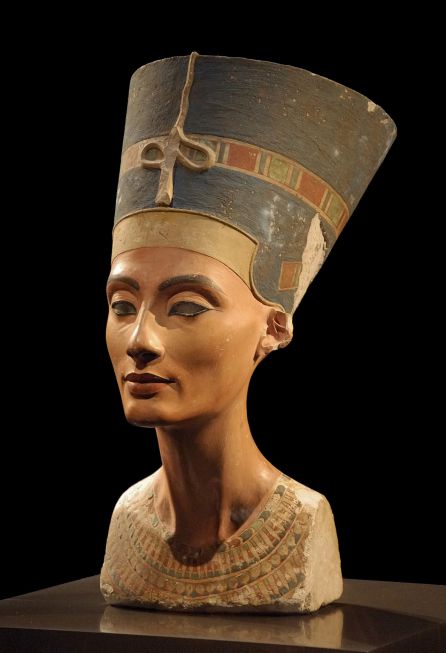 –
–With what little we have, some historians say that the sculpture has a too wide neck to be the same woman from the bust of Nefertiti that is preserved in Berlin but in the absence of a better candidate, nothing beats in beauty and mystery to think that it is Nerfertiti.
What we know about sculpture
Nothing, or very little. No fragment has been found that can be considered to have formed part of this sculpture that was surely a complete standing figure. What we do know is that It was a figure made up of different pieces, surely made of stones of different colors. In the fragment that we keep, an incision, a hole is observed in the neck, which suggests some element that connects the face with the body. The body was probably modeled on a stone of another color (perhaps alabaster) while the face, hands and feet must have been the same yellow jasper.
What is the New Kingdom to which the piece belongs?
It is an extremely unique moment in Egyptian history, and also in human history. Egyptian culture had been in existence for almost 1,000 years when Amenhotep IV or Amenophis IV came to power. It was a culture with traditions, rites, cults and a very marked and determined art (which were reproduced from generation to generation). Suddenly, Amenophis IV arrived and decided to change everything:
- The religious cult changed
- I change the style of art, much freer in the representation of the human body.
- He changed the capital of place, moved it to Amarna
- And renamed: AKHENATON (useful / Aton server)
Suddenly the cult was not all those invisible gods that nobody had seen (except in works of art) of fantastic beings with animal heads (Horus-falcon, Anubis-jackal…). He set aside all those divinities, as if they no longer existed, and determined that the only God was the solar disk: Aton.
What towards the Sun-God ?: basically, in all the images, throw protective hands on Akhenaten, Nerfertiti and their children. That is, to show the other Egyptians that they were the chosen ones by God.
He created his own religion, the first monotheistic religion in history. And it was designated as chosen by that god.
What changed in art with religion
It changed completely, radically, from the rigidity and solemnity of the old figures, it became a much more human representation. Sometimes, in the representations, the pharaohs appear with their children in a loving attitude, hugging them or giving them a kiss (something unthinkable in the previous art).
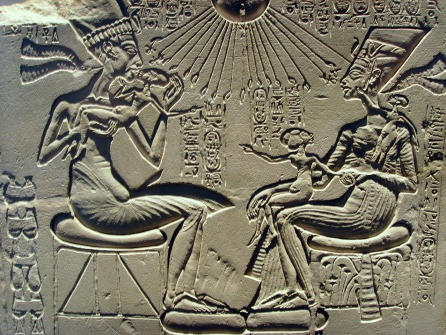 –
–Further, there was an intentional change in the canons of beauty (or of human representation), reaching an almost deformed anatomy: elongated skulls, thick lips, slender necks, prominent chins, excessively thin bodies …
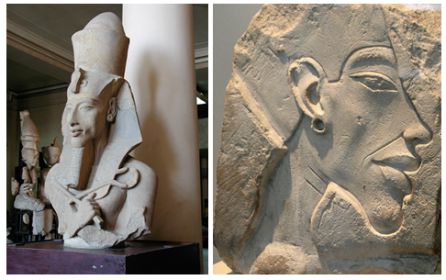 –
–It was a change in all visible strata of Egyptian culture. The artistic change may have been caused by a trip by Akhenaten to Crete or by the trip of Cretan sculptors to Egypt. We will never know.
How was the acceptance?
There was strong discrepancies between society, since the cult of the ancient gods had been eliminated from the roots, deeply rooted among the population that until then was polytheistic. It stood alone as long as the pharaoh, who had absolute power, was alive.
The reign was short-lived, and the new religion also: 17 years (1353-1336). After Akhenaten’s death, the city of Amarna (the new capital) was abandoned (and our sculpture was forgotten there) and the orthodox religion was returned, to the cult of all life. Religion and art returned to the previous cult and rite and thus lasted for the next 1000 years.
Akhenaten’s successor
The most famous pharaoh for us: Tutankhamun (that he was married to the daughter of Akhenaten and Nefertiti and that he himself was possibly Akhenaten’s son with another woman).
Tutankhamun was the one who returned the ancient cult, the millennial gods and also returned to ancient art but thes works from the reign of Tutankhamun are fascinating because they have things from both worlds: it recovers the old style, but with elements of the new.
We see it, for example, in a relief on his throne where the pharaoh looks relaxed on his throne (in a position unthinkable in ancient art) and the queen caresses him in a gesture of complicity. From the Sun God the rays-hands that protect the pharaohs continue to come out.
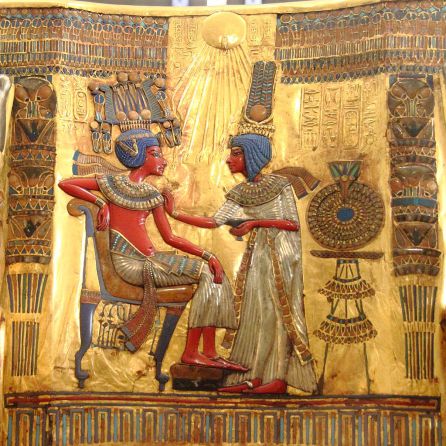 –
––

